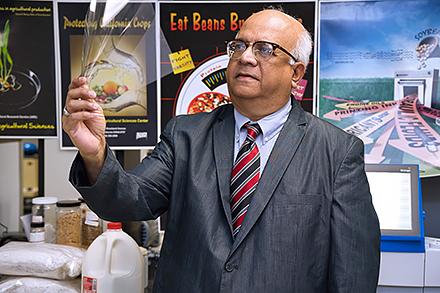No More Crying Over Spilled Milk
As the U.S. seeks solutions to the growing problem of plastic pollution, one ARS scientist is developing a new approach that may help. Atanu Biswas, research chemist at the ARS National Center for Agricultural Utilization Research in Peoria, IL, has spent much of his career researching ways to convert agricultural waste products into bioplastics. Bioplastics, as the name suggests, use biobased materials as the source material, instead of the petrochemical precursors that make up conventional plastics.
Over the years, Biswas has transformed a variety of materials into the innovative bioplastics. His latest effort, however, draws on a source that might be particularly unconventional: dairy waste. The dairy industry typically produces a waste product known as lactose, which is a kind of sugar. Like some other agricultural byproducts, it is composed of a structural building block known as a saccharide, which has the right kind of chemistry to form a bioplastic.

Atanu Biswas inspects a piece of bioplastic in his lab.
Using the molecule as a starting point, Biswas has been able to transform lactose into polyurethane and other bioplastic polymers with wide-ranging potential applications in industry and consumer products. Part of his approach has been to use microwave technology, which allows him to make bioplastic polymers very quickly, a significant advance over previous approaches.
Moreover, Biswas said that because lactose is a disaccharide of galactose and glucose sugars, it will likely be biodegradable, although further research is needed to confirm this point. Overall, Biswas said that lactose-based materials represent a meaningful improvement over existing, petrochemical-based plastics, and can be composted in industrial composting facilities.
One challenge facing scientists who develop new bioplastics is they must replicate a wide variety of characteristics that conventional plastics have, including hardness, flexibility, and other features that make the plastics useful. So far, the dairy-based bioplastics do not replicate the full range of characteristics that conventional plastics offer, and would be useful mainly for certain niche applications, such as insulation, cushioning material for furniture, footwear, rubber flooring, or some medical equipment. With additional work, however, Biswas believes they can be further developed to be useful for hundreds of applications.
“I would say that overall, bioplastics can replace a large part of the conventional plastic supply; whether they can replace it entirely, I’m not sure,” Biswas said. “Eventually, probably everything can be replaced, but it’s a pretty big jump, from where we are now to there.”
For now, though, he said the novel bioplastics represent a “win-win-win situation” for industry, farmers, and consumers. For industry, they represent a chance to present a cleaner, greener image, and to take advantage of a renewable feedstock that is readily available. Consumers who recognize the problem that plastics present will appreciate a less harmful option for the environment. For farmers, finding a use for what would otherwise be waste is also a win.
“Anything you can get from that is wealth from waste,” said Biswas. — Kathryn Markham, ARS Office of Communications

